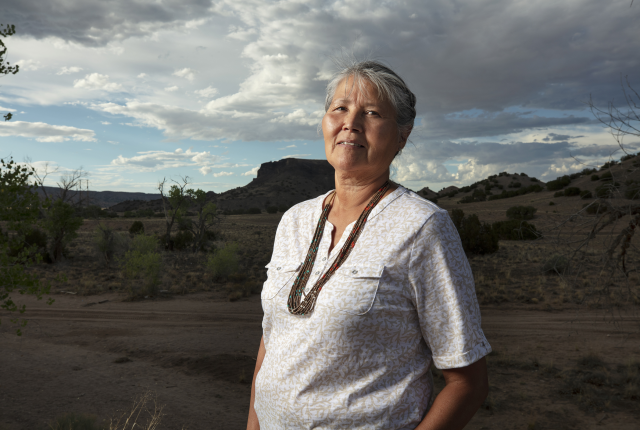This essay is one of 70 by mostly Pueblo people—artists, writers, historians, scientists, and political leaders—collected for "Grounded in Clay: The Spirit of Pueblo Pottery," an exhibition that runs through May 29, 2023, at the Museum of Indian Arts & Culture. For an insider's look at the exhibit, read "Pueblo Pottery Exhibit Breaks the Mold," by Kate Nelson.
WHILE BROWSING the beautiful pots before me, I hear many tiny, faint voices and songs, as if only whispered. I can smell the earth’s clays as my hands carefully touch and embrace the vessels. Shapes of mountains, deserts, spirit lakes, and springs can be seen on some pieces, and their stories can be read in others. For many, I wonder what memories are embedded in their clay’s spirit, and it is then that I find myself drawn to a small tan vessel painted with red-and-black designs of clouds, kiva steps, and a thunderbird. My hands lift the pot and my fingers run over the smooth polish. The shape and workmanship are familiar; I know what family gave life to the piece. As I hold the vessel close, I feel a very slight breeze and a connection to the pot. Pulling it closer to my heart, I feel its spiritual presence.
I close my eyes and am taken back to my childhood, when I was about six or seven years old. It is summer, and my friends and I are playing under the Big Tree. We see elders sitting on their front porch and walk over to them. Their voices are not distinct, but one elder I can see very clearly. She is wearing a dark-blue dress, her hair is tied back, and as she greets us, her smile widens. I smell fresh apples as her presence grows stronger. I notice she is working with clay, shaping it into a ball. We call her by name, and as she responds, I am brought back to the present.
I wonder what part of the vessel was her work: the shaping, the sanding, or the polishing. I question the memory she gave to me at that moment. It was a reminder to remember her and, like her, to find the good in everything and pass it on. She reminded me to be happy with my gifts and always be in good spirits. She came to me for a moment, a moment I now share with you, one that is so precious and beautiful.
Many journeys are embedded in the clay by those who created the vessels. When a pot is shaped, it is given life and carries the memories of its maker’s life stories and songs. If you listen carefully, you may hear one of these stories. It may be for only a moment, and the sounds may be faint and distant, but if you listen closely, you may hear the pots recall a fragment of the many memories they hold.
*Ko’o Paa was a sister of Maria Martinez and was deaf and mute. Ko’ois is Tewa for “aunt.” Paa, Tewa for “apple,” was her given name. She was also known as Clara Montoya. Although she could not hear or speak, Ko’o Paa could sense when someone was calling her.
Read More: Don't miss essays by Diego Medina, Claudia Mitchell, Melissa Talachy Romero, Mateo Romero, and Dominique Toya.



